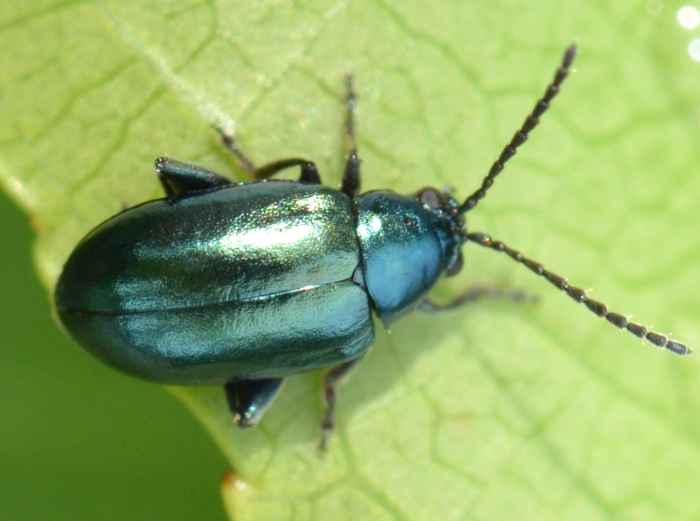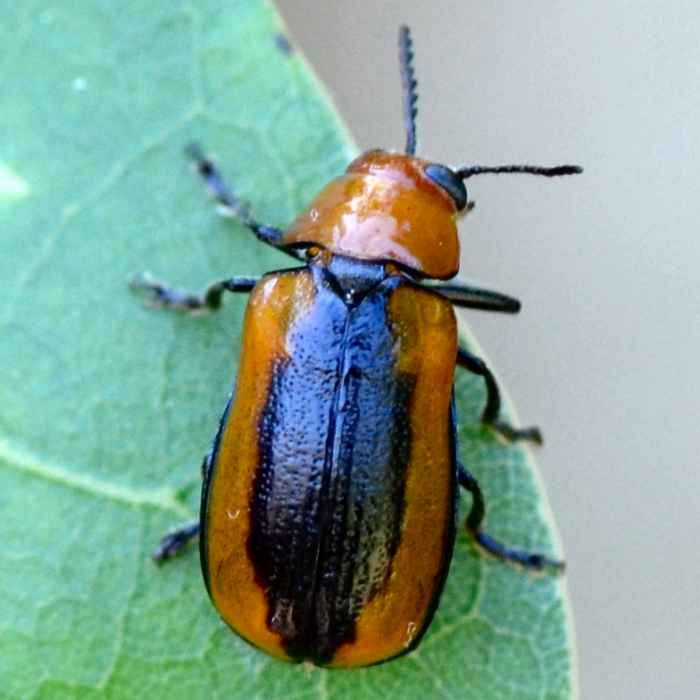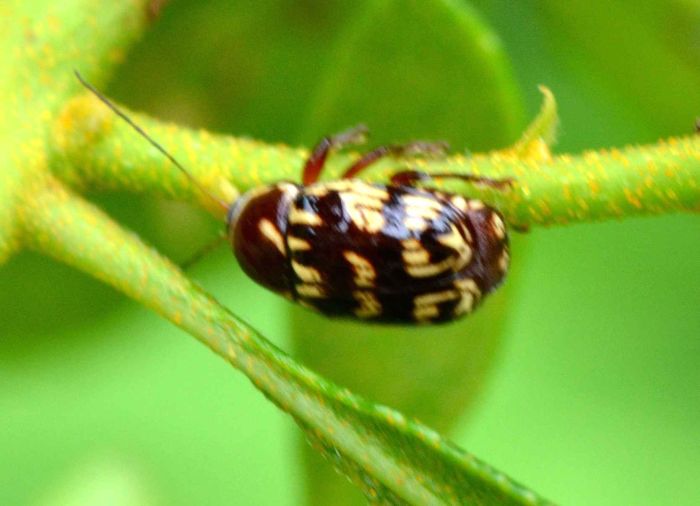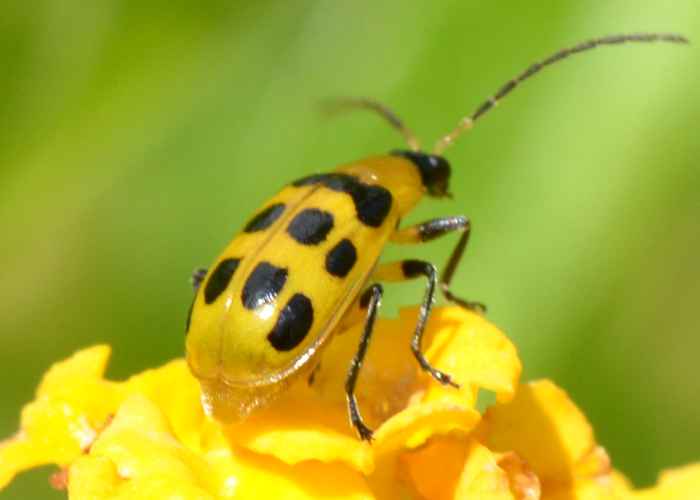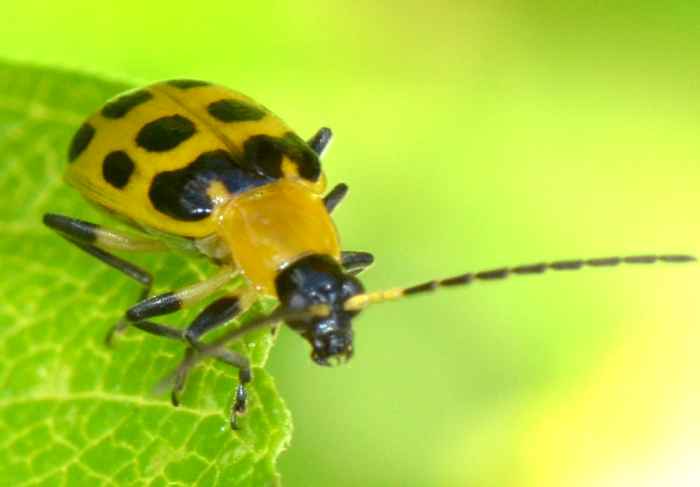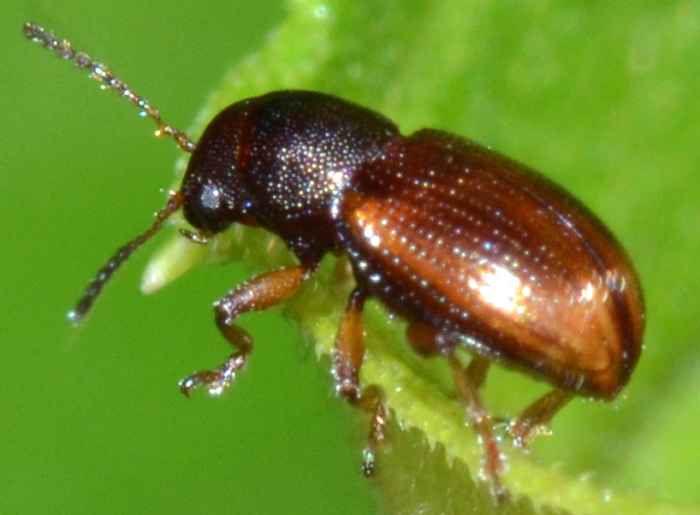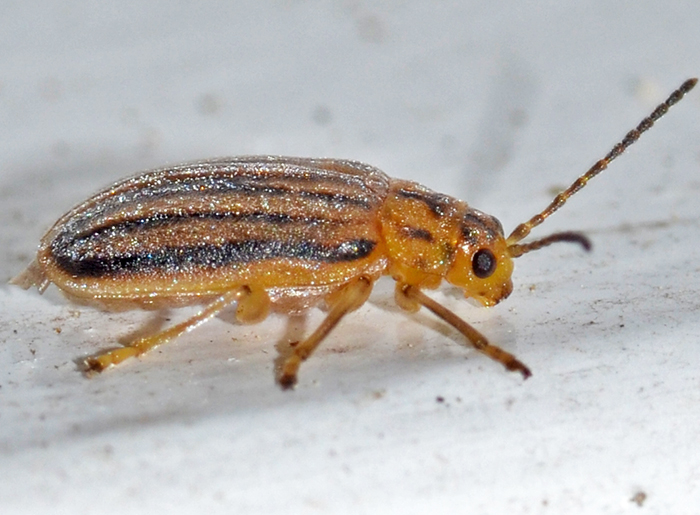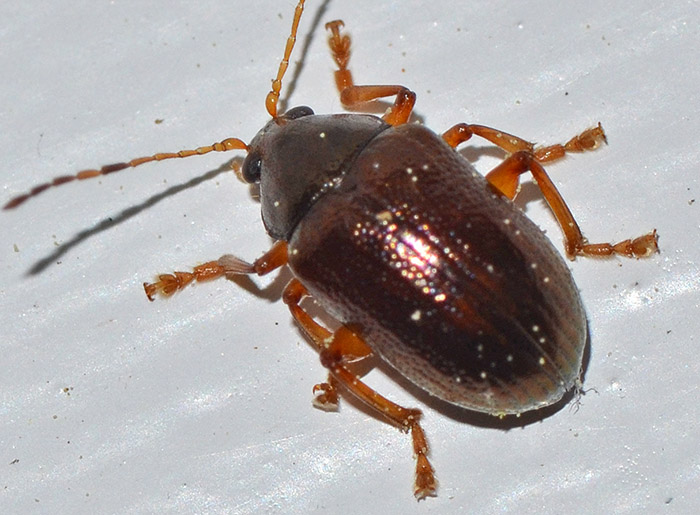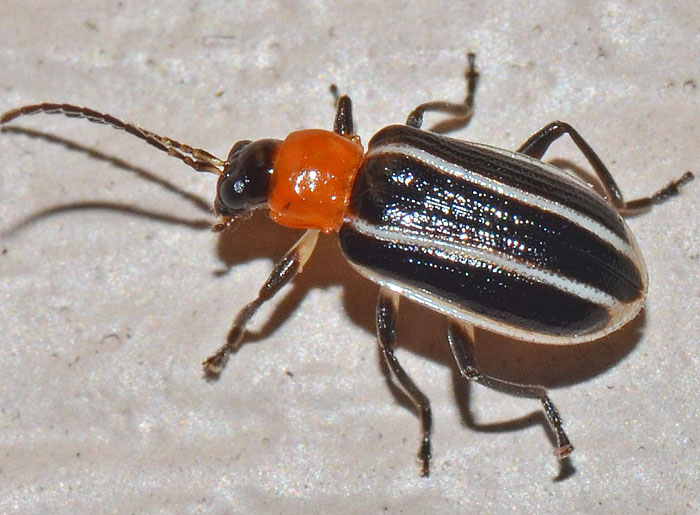 Acalymma vinctum. | This small leaf beetle is Acalymma vinctum which is primarily found in the Southeastern US. The genus has six species in North America; all of them feature three distinctive dark stripes. bug guide (this photo): http://bugguide.net/node/view/1101974 | ||
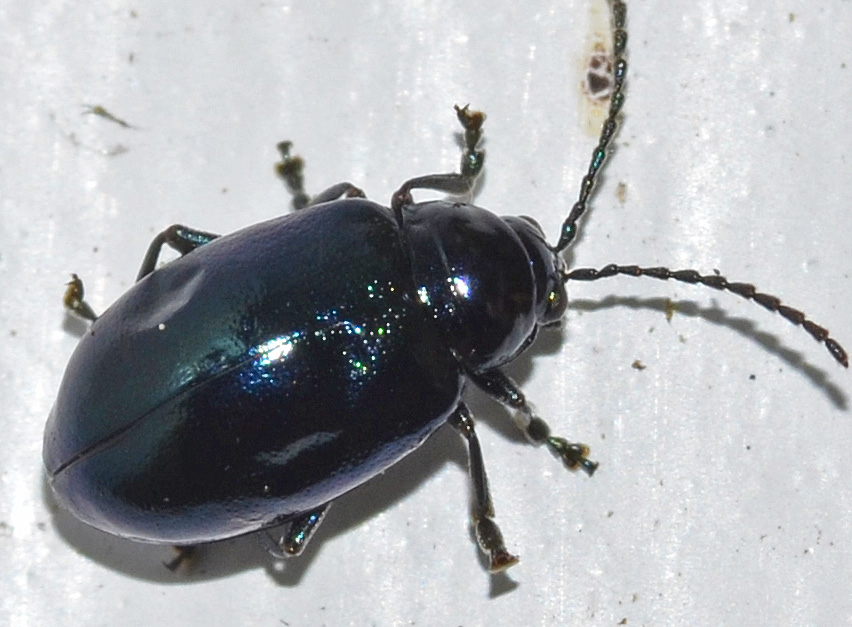 Altica sp. (Shiny Flea Beetle). | This flea beetle belongs to the genus Altica which has approximately 70 species north of Mexico. Adult beetles can jump away when approached. The small photo is from 09/05/11 (11 am).
bug guide (this photo): http://bugguide.net/node/view/1223608 wikipedia: http://en.wikipedia.org/wiki/Altica | ||
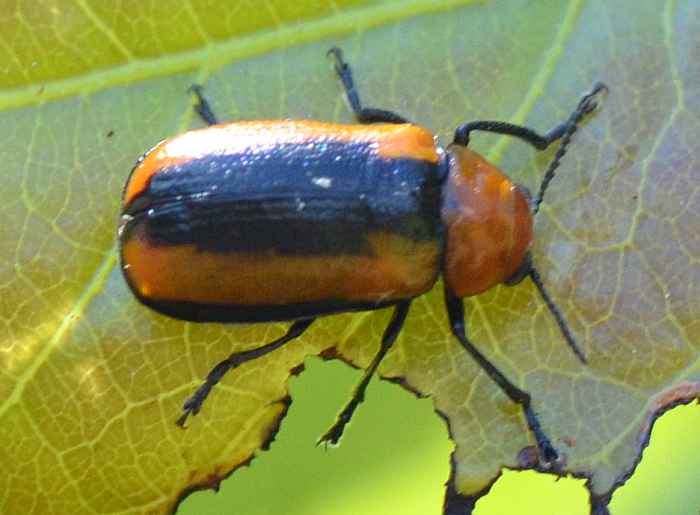 Anomoea laticlavia (Clay-colored Leaf Beetle). | Anomoea laticlavia is fairly large leaf beetle that is also known as Persimmon Leaf Beetle. Their habitat includes old fields with growing shrubs. They feed on variety of plants such as honey locust, willow, oak, persimmon, and ragweed. The amount of black on their elytra is highly variable.
bug guide (this photo): http://bugguide.net/node/view/627757 | ||
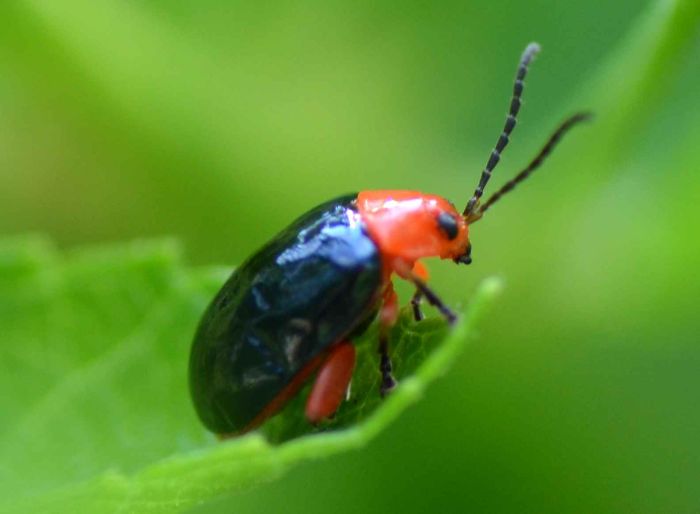 Asphaera lustrans (Shiny Flea Beetle). | A (truly) Shiny Flea Beetle (Asphaera lustrans). This species migrated into Florida during the 1990s but is now widespread. According to the bug guide, it is sometimes referred to as Gator bug in reference to the UF colors (orange and blue). To me this beetle looks more like orange and black, so Seminole bug would be an equally poor description :). A. lustrans is--like many flea bugs--a very good jumper (see strong hind legs/femora). bug guide (this photo): http://bugguide.net/node/view/558092/bgimage | ||
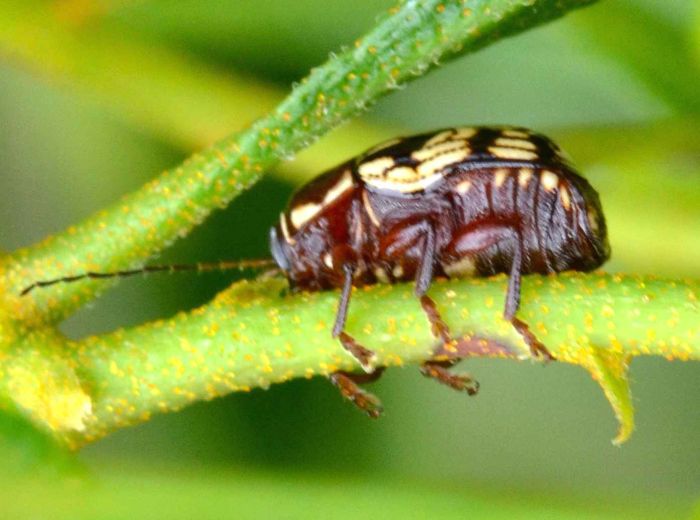 Bassareus brunnipes (Case-Bearing Leaf Beetle). | This Case-Bearing Leaf Beetle is Bassareus brunnipes. The Greek word bassaris refers to 'fox'. The beetles in this subfamily (Cryptocephalinae) are small and of cylindrical shape. They have long antennae and their head is inserted into the prothorax. The small photo shows the same specimen.
bug guide (this photo): http://bugguide.net/node/view/560187 | ||
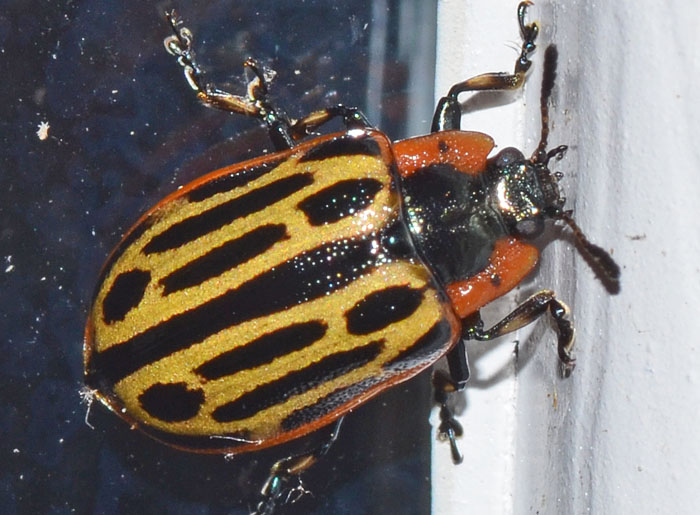 Chrysomela scripta (Cottonwood Leaf Beetle). | The Cottonwood Leaf Beetle feeds on willows and poplars. I understand that the term 'cottonwood' refers to certain types of poplars. The larvae skeletonize leaves, whereas the adults feed on large veins. It can cause extensive leaf loss which subsequently reduces stem volume up to 70%. In earlier times, this common beetle was considered a pest because willows were grown commercially for baskets. bug guide (this photo): http://bugguide.net/node/view/1058806 UF: http://entnemdept.ufl.edu/creatures/trees/beetles/cottonwood_leaf_beetle.htm | ||
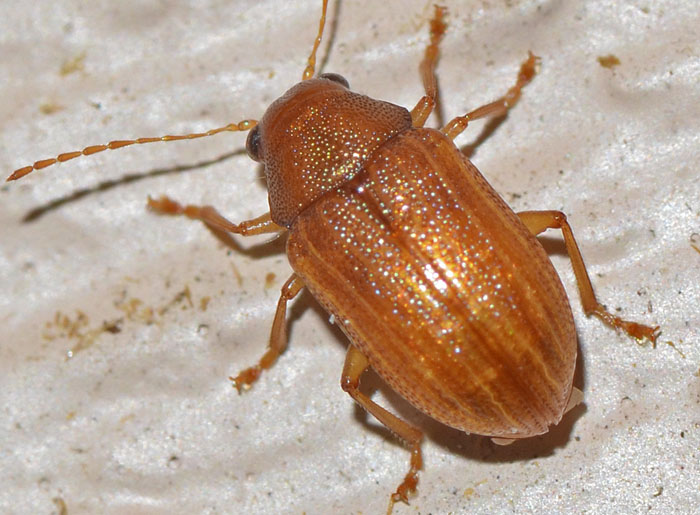 Colaspis sp.. | This genus has 28 species in the US and over 200 worldwide. bug guide (this photo): http://bugguide.net/node/view/41307 | ||
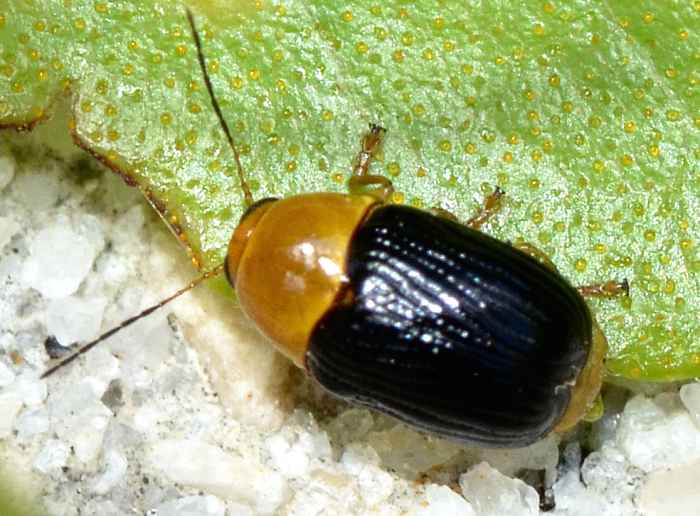 Cryptocephalus nanus. | This tiny leaf beetle is Cryptocephalus nanus. It belongs to the Arizonensis group which consists of the five species C. arizonensis, nanus, nigrocinctus, sanguinicollis, and pallidicinctus. The genus Cryptocephalus includes of over 70 species in North America. bug guide (this photo): http://bugguide.net/node/view/632849 Mike Quinn: http://www.texasento.net/Crypto.html | ||
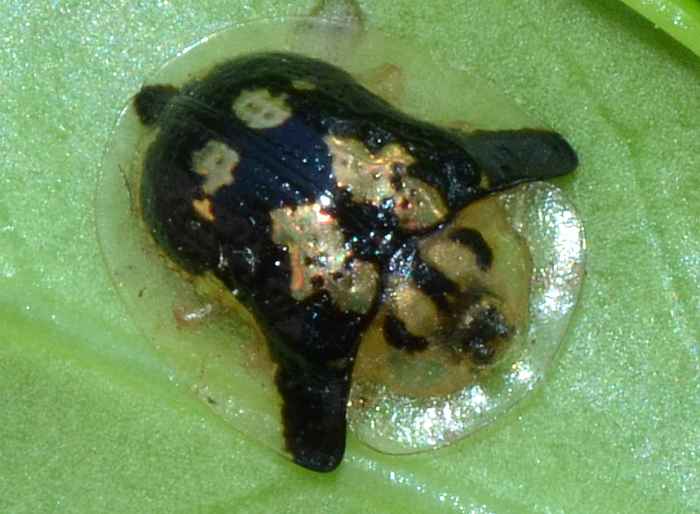 Deloyala guttata (Mottled Tortoise Beetle). | Bizarre! This is an adult. The second link shows a Mottled Tortoise Beetle walking. bug guide (this photo): http://bugguide.net/node/view/633790 Troy Bartlett: http://naturecloseups.com/posts/taxa/deloyala-guttata | ||
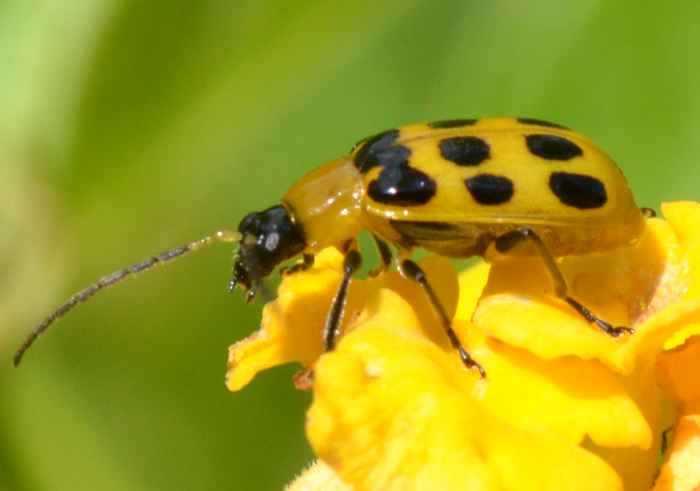 Diabrotica undecimpunctata (Spotted Cucumber Beetle). | I believe this is a Spotted Cucumber Beetle (Diabrotica undecimpunctata). The larval stage is also known as Southern Corn Rootworm. Adult beetles are yellow to green with eleven black spots on the elytra. In this specimen three spots have merged (best seen in the right photo below). They are considered a major pest damaging cucumbers, squashes, corn, soy, and also some garden plants such as hibiscus and roses.
bug guide (these photos): http://bugguide.net/node/view/573716 | ||
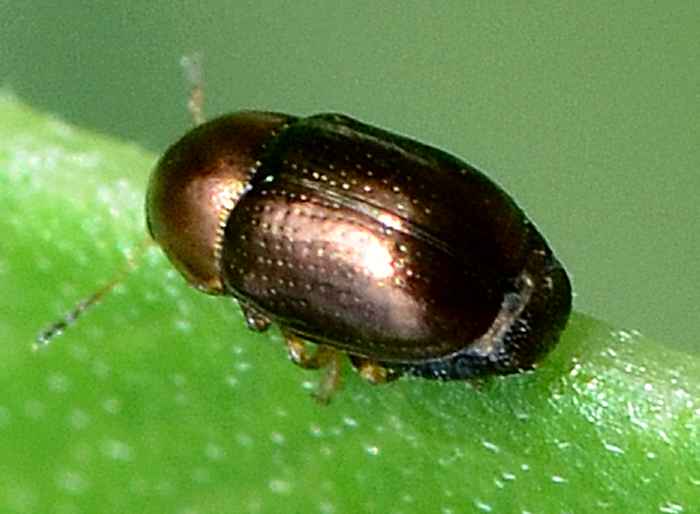 Diachus auratus (?) (Bronze Leaf Beetle). | The genus Diachus includes ten species in North America but has not been revised since LeConte studied it in 1880. This specimen possibly is a Bronze Leaf Beetle (Diachus auratus). bug guide (this photo): http://bugguide.net/node/view/632439 | ||
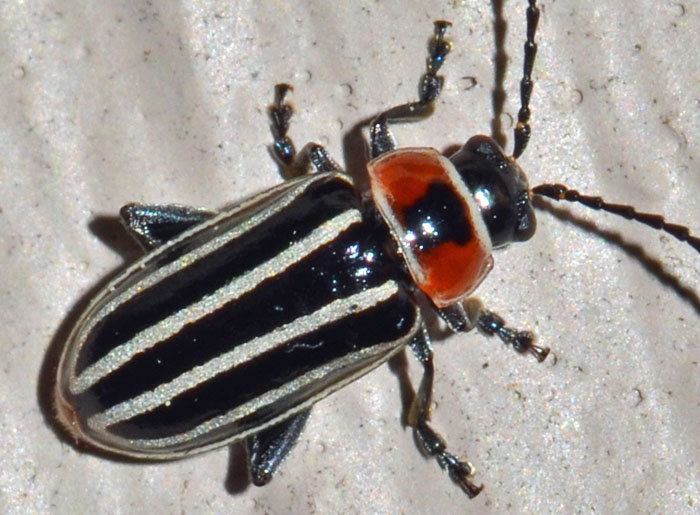 Disonycha pensylvanica. | Another pretty flea beetle. Disonycha pensylvanica is usually found near aquatic habitats. Its typical hosts are Polygonum spp. including smartweed. bug guide (this photo): http://bugguide.net/node/view/1066934 | ||
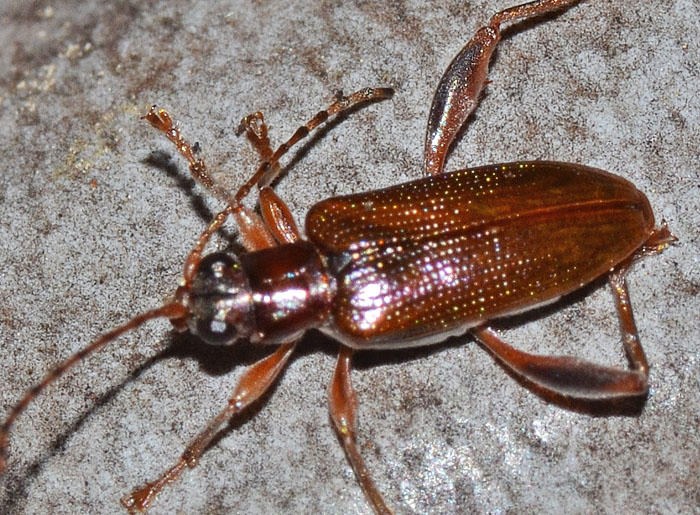 Donacia sp.. | Not the best photo but my first aquatic leaf beetle (subfamily Donaciinae) which typically have strongly enlarged femora. The femora are the third segment of the leg (counting from the base), situated between the trochanter and the tibia. The larvae are aquatic and attached to host stems or roots; adults are found on vegetation bordering standing water. Interestingly, the larvae tap the submerged stems of host plants for oxygen and food.
bug guide (this photo): http://bugguide.net/node/view/1077861 | ||
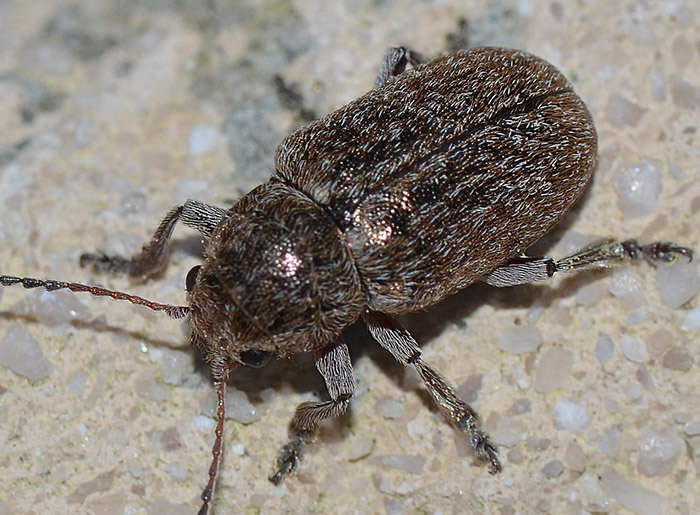 Glyptoscelis sp. | This hairy leaf beetle is not so common in Florida. Nonetheless, the genus Glyptoscelis features 26 species in the US with most of them occuring in the West. bug guide (this photo): https://bugguide.net/node/view/1953311 | ||
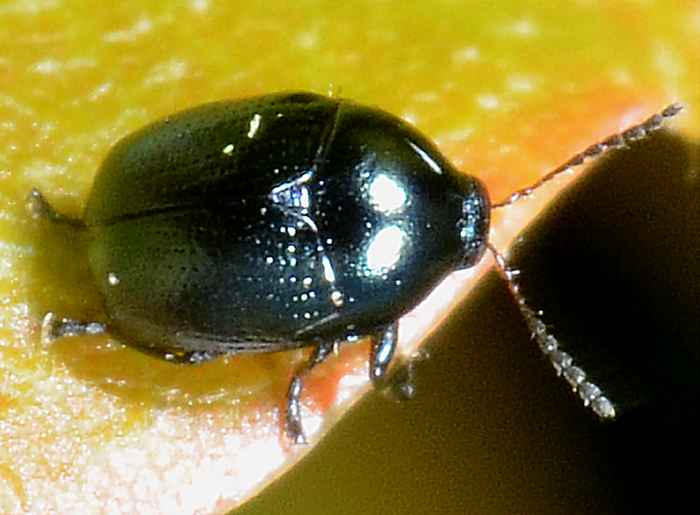 Lexiphanes saponatus. | According to the bugguide Lexiphanes saponatus can be found in the eastern United States and southern Canada. The second link states that "Unlike most other cryptocephaline larvae which live in the leaf litter and are unable to climb on plants, the larva of L. saponatus moves easily on its host plant (Cassandra calyculata) and mimics perfectly the plant buds, becoming almost invisible to the human eye." bug guide (this photo): http://bugguide.net/node/view/659263 L. LeSage, The Canadian Entomologist 116, 537 (1984): http://pubs.esc-sec.ca/doi/abs/10.4039/Ent116537-4 | ||
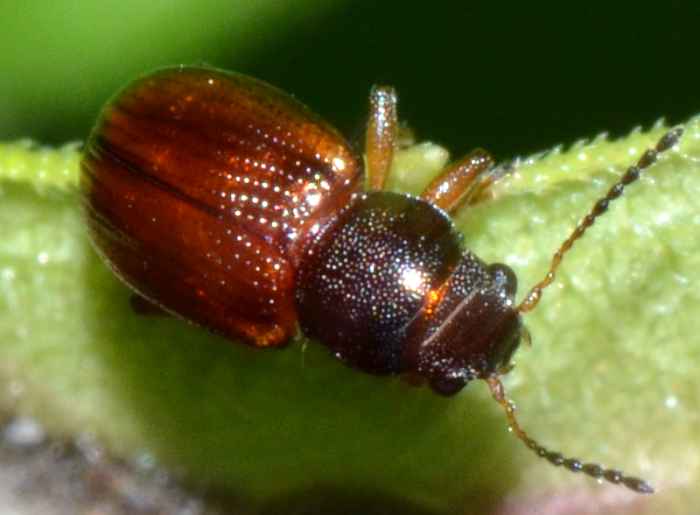 Metachroma longicolle. | A small leaf beetle named Metachroma longicolle. To me it looks distinctly different from the Metachroma sp. specimen that I have posted above.
bug guide (these photos): http://bugguide.net/node/view/664735 | ||
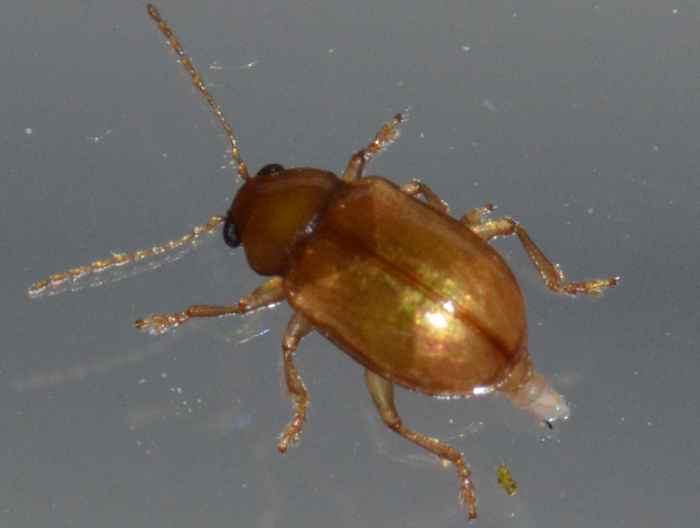 Metachroma sp. (?). | This little fellow belongs to the family of Leaf Beetles. It is probably Metachroma sp. (possibly Paria sp.) This genus has 40 species in North America. bug guide (this photo): http://bugguide.net/node/view/576586 | ||
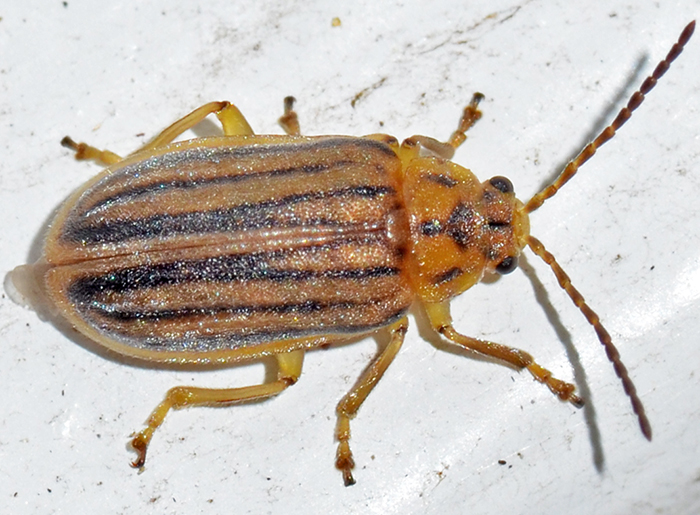 Ophraella sp.. | Ophraella encompasses 14 species in the US. Their food includes flowers from the Asteraceae family (e.g., sunflowers). O. communa is my favorite because it is a successful biological control agent against ragweed.
bug guide (these photos): https://bugguide.net/node/view/1547505 | ||
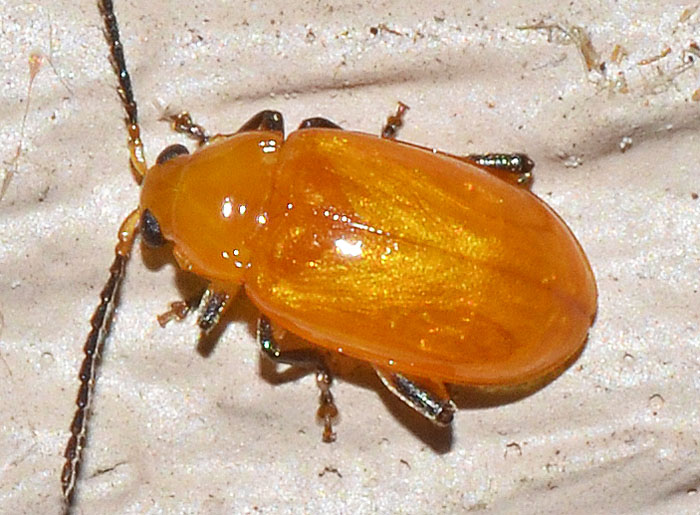 Parchicola tibialis. | This small flea beetle is Parchicola tibialis. It feeds on plants in the Passifloraceae family. The genus has two species in North America. bug guide (this photo): http://bugguide.net/node/view/1106084 | ||
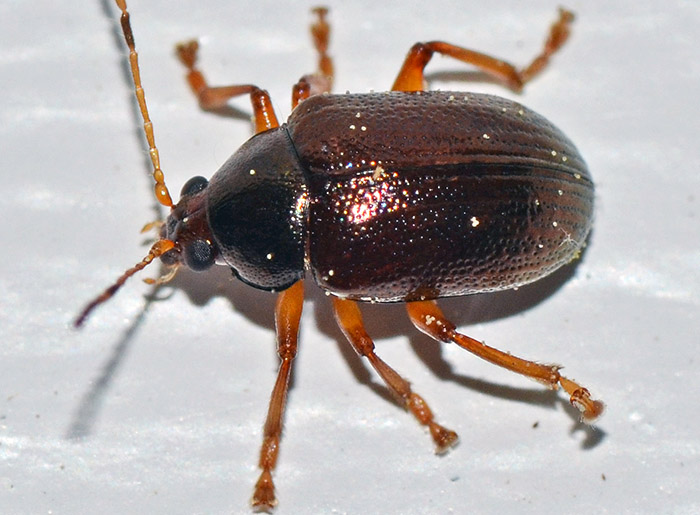 Rhabdopterus sp.. | Nice photo of a little leaf beetle. There are eight species of Rhabdopterus in the US, which favor plants including oak and hackberry (nettle tree) as their host. The small photo shows the same specimen.
bug guide (these photos): https://bugguide.net/node/view/1509566 | ||
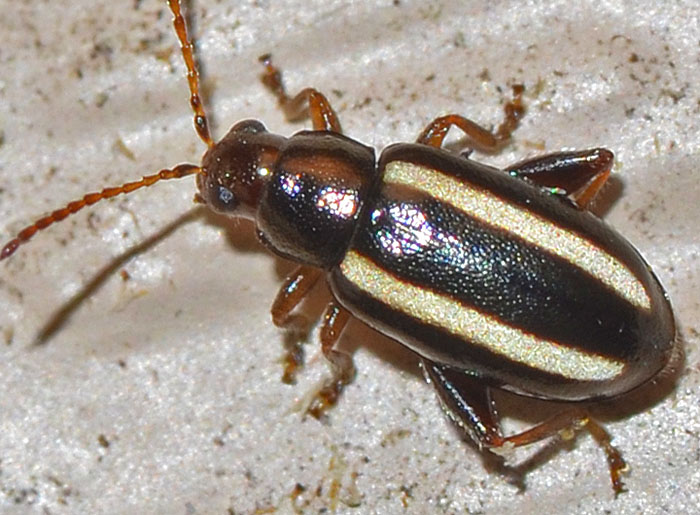 Systena blanda (Palestriped Flea Beetle). | A pretty, little flea beetle. It seems to fly from May to August and is not a very common find, perhaps partly because of its small size. I believe this little fellow was attracted to our porch light. Notice the enlarged hind femora which makes this flea beetle a good jumper. My specimen, however, was casually strolling on our house wall. bug guide (this photo): http://bugguide.net/node/view/985595 |

